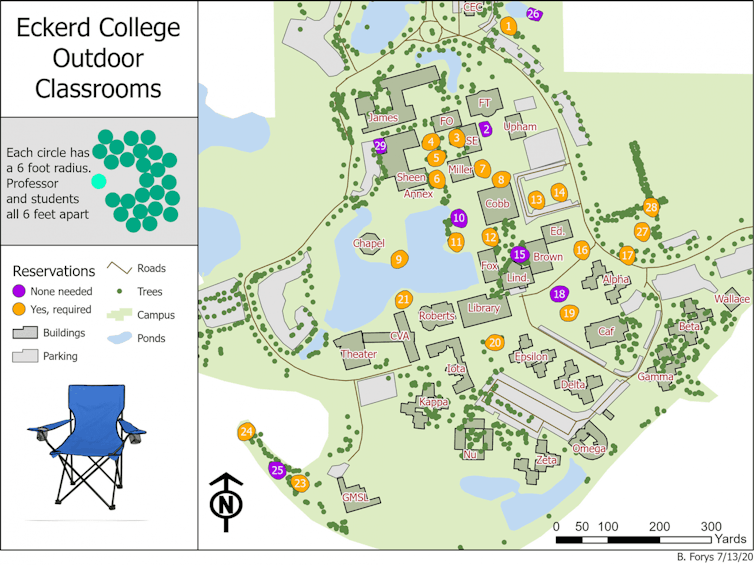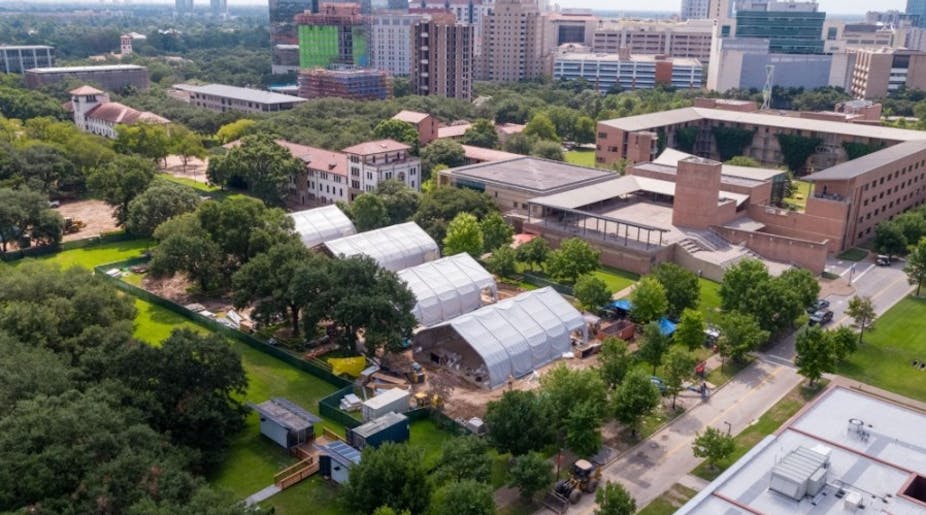When it comes to conducting classes this fall, most colleges seem to be stuck between holding in-person or remote classes, or some combination of the two. As a researcher who focuses on the design of educational spaces, I believe there’s a fourth option that’s not being given its due: outdoor spaces, such as open-air tents.
From a learning space design perspective, this could be an effective way of maintaining in-person instruction, even when temperatures drop later in the fall.
A few universities are taking class meetings outside as an innovative way to safely keep students on campus.
For instance, Rice University in Houston, Texas, Amherst College a small liberal arts college in Amherst, Massachusetts, and Eckerd College in St. Petersburg, Florida, are among those who have committed to using outdoor classroom spaces to mitigate the risk of viral spread.
These institutions are not looking to merely hold classes outside on nice days, but to find solutions to support regular class meetings outside even in cooler weather. These innovative outdoor learning options might have a future on the other side of the current pandemic.
A closer look
Rice University has constructed five open-air tents that will each accommodate classes of 25 to 30 students. Each tent is large enough to allow students and instructors to stay six feet away from each other during class.
In addition to the five tents, Rice is building four temporary buildings that will each support classes of up to 50 students at a time, allowing more people to learn on campus than existing buildings can support. The temporary buildings will have sturdy floors and walls and may be used to hold classes beyond this coming school year. While these are not permanent, brick and mortar buildings, their physical structures offer a more long-term option for holding classes compared to tents. These structures will be connected to electricity to enable cooling, heating and lighting – like the tents – allowing students and faculty to plug in any educational technology they may need or want, such as Wi-Fi or laptops.
Kevin Kirby, vice president for administration at Rice, detailed how these structures will lessen the risk of the spread COVID-19 this fall. The open-air design aligns with research that suggests the virus spreads less efficiently outdoors than indoors. Kirby says the open-air tents also help reduce the number of people inside campus buildings. In other words, the more class sections that are held in these outdoor structures, the fewer students and faculty there will be inside buildings at one time.
“They’re designed to withstand hurricane force winds,” Kirby wrote. “They can be used not only for instruction, but also for academic lectures in the late afternoon and student meeting and study spaces in the evenings.”
The University of California, Davis is also constructing tents to hold classes outside.
Enduring the elements
Outdoor learning is not just the provenance of the Southern or West Coast institutions with milder winters. Amherst College in Massachusetts is making similar investments in the infrastructure required to support outdoor learning that officials there hope will allow for a near normal fall semester for its students. The liberal arts college with fewer than 2,000 undergraduates purchased 20 tents to hold classes outside. Most classes held in the tents will be small, seminar-style meetings that remain at the heart of the Amherst undergraduate experience. The tents will be equipped with electricity to support learning technology and heating mechanisms when the need arises.
Amherst, like many schools across the country, will pivot entirely to remote instruction after the Thanksgiving break. Schools are avoiding bringing students back to campus after the November holiday to reduce the chance of coronavirus case spikes in concert with large influxes of students who will undoubtedly have spent time in close contact with friends and family over the break. For Amherst and other institutions that experience cold winter climates, keeping students off campus after Thanksgiving cuts down on the need to depend on outdoor learning spaces into December.
Eckerd College in St. Petersburg, Florida, made headlines in July for its creative plan to encourage outdoor instruction. The school will encourage any instructor who wants to teach classes outside to do so. A professor of environmental studies and experienced outdoor instructor, Elisabeth A. Forys, proposed the idea of using geographic information systems (GIS) technology to map and visualize all viable outdoor spaces on the 188-acre campus where classes could be held.

Forys and faculty colleague Noëlle Boucquey worked together to take inventory of available outdoor spaces, evaluating each location for shade and wind conditions and designing a system for reserving space for classes. Almost all of the locations in the GIS mapping inventory have suitable Wi-Fi access.
[Deep knowledge, daily. Sign up for The Conversation’s newsletter.]
Claremont McKenna College will encourage faculty to teach outdoors as well when the weather permits. The small liberal arts college is purchasing more outdoor furniture to support open-air meeting spaces around campus. Arizona State University plans to do the same. While these schools will not formally schedule classes to meet in outdoor venues, they are adding infrastructure to make outdoor spaces more conductive to holding group meetings.
Campus after COVID-19
The coronavirus pandemic has inspired the world of higher education to reconsider the ways physical campus spaces are used to support student learning. Several studies support the idea that being outside helps students learn. Studies also suggest that there are positive associations between memory function and the types of emotions students experience while outside. In other words, there is evidence that students remember more information when they learn in an outdoor setting. Students’ mental health also may benefit from spending time outdoors, a finding that is especially relevant for students who attend college amid the stress of COVID-19. As colleges continue to wrestle with whether to have students on campus in regular buildings or learning remotely at home, we believe outdoor learning spaces could prove to be a better option than both.

